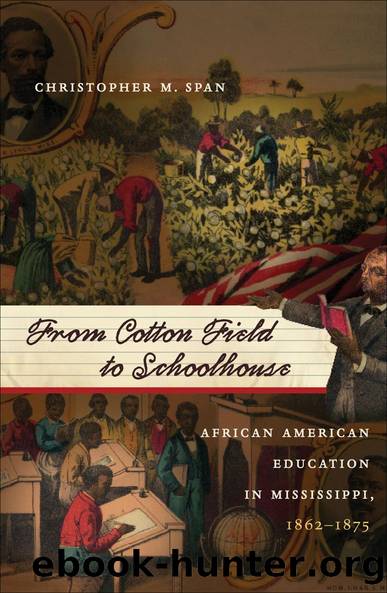From Cotton Field to Schoolhouse by Christopher M. Span

Author:Christopher M. Span [Span, Christopher M.]
Language: eng
Format: epub
Tags: Social Science, Ethnic Studies, American, African American & Black Studies, Education, History, United States, 19th Century
ISBN: 9781469601335
Google: ROPkbu5VjtgC
Publisher: UNC Press Books
Published: 2012-04-01T02:40:23+00:00
Race Educable
Children
(Ages5â21) Number
of Children
Enrolled
in Schools Percentage
of Children
Enrolled Average
Attendance
of Enrolled
Children Average
Attendance as
a Percentage
of Enrolled
Children
Black 126,769 45,429 35.8 36,040 79.3
White 120,073 66,257 55.1 49,290 74.4
Total 246,842 111,686 45.2 85,530 76.4
Source: Adapted from Annual Report of the Superintendent of Public Education of the State of Mississippi for the Year Ending December, 1871 (Jackson, Miss.: Kimball, Kaymond, State Printers, 1872), 124â31.
Black and white children benefited. As table 4 shows, approximately 45,429 out of the 126,769 black children, or 35.8 percent, enrolled in public school. Almost 80 percent of these children attended school on a daily basis. Comparably, 66,257 out of the 120,073 white children, or 55.1 percent, enrolled in public school, and approximately 74.4 percent of these students maintained a daily attendance. While black children constituted a majority of the children in the stateâroughly 51.3 percentânearly 21,000 more white children were enrolled in school. This result, however, had more to do with the educational opportunities available to black childrenâsmaller or fewer schools or fewer teachersâthan with the enthusiasm or attitudes they had toward schooling. As table 4 indicates, black children who enrolled in a public school regularly attended when the opportunity to do so arose.
That black children attended school when they had the chance to do so is more apparent when one looks at attendance by county. In majority-black counties, Mississippi blacks took full advantage of the educational opportunities before them. Their majority representation, mounting economic leverage, and growing political voice assisted them in their educational pursuits. Moreover, the fact that so many African Americans could financially contribute to the burgeoning public school system greatly increased their childrenâs schooling opportunities. The two-dollar poll tax on all adult males (including freed black males) was paid and collected in these counties, butâas it will be seenâmuch of the monies raised from this tax went more toward the establishment and perpetuation of white rather than black public schools.
On average, as table 5 demonstrates, the enthusiasm blacks maintained toward public schooling in these predominantly black counties, if again measured by average daily attendance, was slightly more pronounced than their white counterpart.55 On average, roughly 82 percent of black children who enrolled and 76 percent of white children who enrolled attended school. More evident, however, were statistics that suggest the seemingly apparent disregard black children held for attending school. Only 21,327 out of the counties' 72,873 black children, or 28 percent, enrolled in a public school. In contrast, 18,584 out of the counties 37,920 white children, or approximately 48 percent, enrolled in a public school. These statistics, if studied alone, offered a direct challenge to the contentions by contemporary historians that southern blacks strongly favored the possibility of attending school.56
Then again, as table 6 reveals, these totals are misleading and do not reflect a disregard for learning or a change in attitude on the part of blacks toward the idea of universal schooling. Rather, they reflect the limited or poor schooling opportunities available to black children. Charles C. Walden, superintendent of Adams County, spoke of this when he summarized the shoddy conditions of the schools established for blacks in the inaugural year.
Download
This site does not store any files on its server. We only index and link to content provided by other sites. Please contact the content providers to delete copyright contents if any and email us, we'll remove relevant links or contents immediately.
The Art of Coaching Workbook by Elena Aguilar(50962)
Trainspotting by Irvine Welsh(21516)
Twilight of the Idols With the Antichrist and Ecce Homo by Friedrich Nietzsche(18501)
Fangirl by Rainbow Rowell(9093)
Periodization Training for Sports by Tudor Bompa(8167)
Change Your Questions, Change Your Life by Marilee Adams(7633)
This Is How You Lose Her by Junot Diaz(6777)
Asking the Right Questions: A Guide to Critical Thinking by M. Neil Browne & Stuart M. Keeley(5629)
Grit by Angela Duckworth(5512)
Red Sparrow by Jason Matthews(5389)
Paper Towns by Green John(5086)
Room 212 by Kate Stewart(5034)
Ken Follett - World without end by Ken Follett(4643)
Housekeeping by Marilynne Robinson(4328)
The Sports Rules Book by Human Kinetics(4288)
Double Down (Diary of a Wimpy Kid Book 11) by Jeff Kinney(4204)
Papillon (English) by Henri Charrière(4195)
The Motorcycle Diaries by Ernesto Che Guevara(4009)
Exercise Technique Manual for Resistance Training by National Strength & Conditioning Association(3954)
